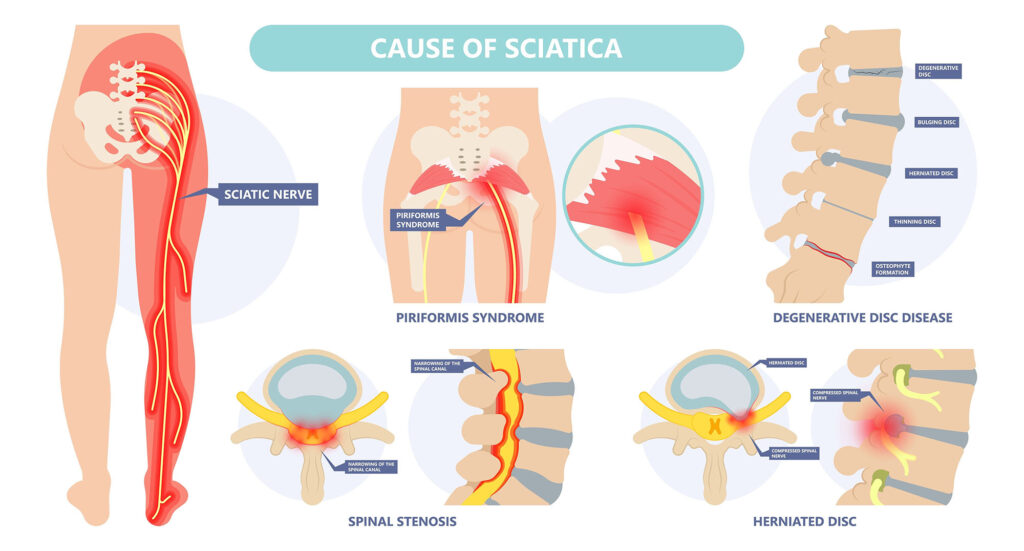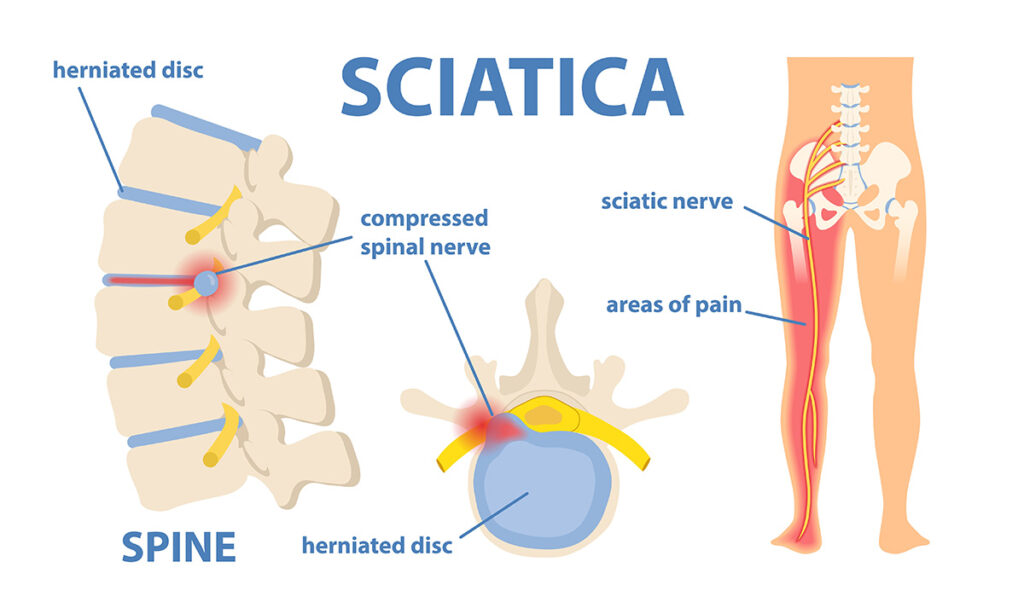Sciatica is a common, often debilitating condition that occurs when the sciatic nerve—the largest nerve in the body—becomes compressed or irritated. This can lead to pain radiating from the lower back, through the hips, and down one or both legs. Sciatica is often linked to several underlying conditions, including disc bulges, central canal stenosis, foraminal canal stenosis, and piriformis syndrome.

At Riverside Wellness Centre, we recognise that osteopathic care plays a crucial role in alleviating sciatica by addressing dysfunctional joints, optimising spinal alignment, and improving the resting tone of connective tissues.
Below, we explore each contributing condition, its causative factors, signs and symptoms, and how osteopathic treatment can provide relief.
– Understanding Disc Bulges: A disc bulge, also known as a herniated or slipped disc, occurs when the cushioning discs between the vertebrae begin to protrude. This protrusion can compress nearby nerves, often including the sciatic nerve, leading to painful sciatica symptoms.
– Causes: Disc bulges are often caused by age-related degeneration, heavy lifting, repetitive movements, or poor posture. Over time, the discs lose hydration, which can compromise their flexibility and increase the risk of bulging. Lifestyle factors such as obesity and a sedentary lifestyle can further contribute to the development of disc bulges.

– Signs and Symptoms: The symptoms of a disc bulge that leads to sciatica include sharp pain radiating from the lower back into the buttocks, thigh, calf, and sometimes the foot. Pain may worsen with specific movements such as bending, twisting, or prolonged sitting.
– Osteopathic Approach to Treatment: Osteopathic care for disc bulges involves correcting joint alignment, releasing muscular tension, and restoring the spine’s natural curvature. Through gentle manipulations and mobilisations, osteopaths help relieve nerve compression, reduce pain, and support the disc’s natural recovery. By improving spinal alignment and reestablishing the balance of connective tissues, osteopathic treatment aims to reduce stress on the discs and restore proper biomechanics.
– Understanding Central Canal Stenosis: Central canal stenosis is a narrowing of the central spinal canal, the passageway for the spinal cord and nerve roots. When this narrowing occurs, it can lead to pressure on the sciatic nerve, resulting in sciatica.
– Causes: This condition is commonly a result of osteoarthritis, degenerative disc disease, or thickening of spinal ligaments. Age-related changes, trauma, and genetic factors can also contribute to the narrowing of the spinal canal.
– Signs and Symptoms: People with central canal stenosis often experience radiating pain, numbness, tingling, and weakness in the lower extremities. Pain may worsen with standing or walking and improve when leaning forward, as this posture can temporarily relieve pressure on the spinal nerves.
– Osteopathic Approach to Treatment: In treating central canal stenosis, osteopaths focus on restoring spinal flexibility, improving joint alignment, and addressing muscular imbalances that may contribute to the condition. Techniques such as spinal mobilisation, gentle stretching, and soft tissue therapy help alleviate nerve pressure, enhance circulation, and restore natural spinal function. Osteopathic care aims to optimise biomechanics, reducing the likelihood of further canal narrowing and associated nerve compression.

– Understanding Foraminal Canal Stenosis: Foraminal canal stenosis involves the narrowing of the small openings between each vertebra, where nerve roots exit the spinal cord. When the foraminal canals become narrowed, they can compress the sciatic nerve roots, causing sciatica.
– Causes: Foraminal stenosis often results from arthritis, disc degeneration, or the formation of bone spurs. Poor posture, repetitive stress, and aging also contribute to the degeneration of foraminal canals. Additionally, overuse or trauma can lead to muscle tightening around the spine, further narrowing the foraminal canals.
– Signs and Symptoms: This condition typically results in localised lower back pain, radiating pain along the sciatic nerve pathway, and sometimes muscle weakness. Pain may increase with certain movements that compress the narrowed foramina, such as bending or twisting.
– Osteopathic Approach to Treatment: Osteopathic treatment for foraminal canal stenosis emphasises decompressing the affected nerves by adjusting spinal alignment and reestablishing the resting tone of surrounding muscles and connective tissues. Techniques may include gentle manipulation, soft tissue therapy, and stretching exercises aimed at relieving nerve compression. By addressing both the structural and soft tissue components, osteopathy can help restore the foraminal canals’ optimal function and ease sciatica symptoms.
– Understanding Piriformis Syndrome: Piriformis syndrome occurs when the piriformis muscle, located deep in the buttock, irritates or compresses the sciatic nerve. Unlike other conditions, piriformis syndrome affects the nerve outside the spine and is a common cause of sciatica-like pain.
– Causes: This condition often develops due to muscle imbalances, prolonged sitting, trauma, or overuse from activities like running. The piriformis muscle can become tight or spasm, placing direct pressure on the sciatic nerve and causing pain.

– Signs and Symptoms: Typical symptoms of piriformis syndrome include a deep, aching pain in the buttock, which may radiate down the leg along the sciatic nerve pathway. The pain may worsen with activities that involve hip rotation or prolonged sitting.
– Osteopathic Approach to Treatment: Osteopathic care for piriformis syndrome focuses on releasing muscle tension and restoring pelvic alignment. Techniques like myofascial release, soft tissue manipulation, and targeted stretching help ease the pressure on the sciatic nerve. By reestablishing balance in the piriformis and surrounding muscles, osteopathy can alleviate sciatica symptoms and prevent recurrence.
At Riverside Wellness Centre, our osteopathic approach to sciatica emphasises addressing the root cause of sciatic nerve compression and relieving associated pain. We consider the body’s structural and functional aspects, focusing on three main principles:
Sciatica often arises from misaligned joints or vertebrae that place pressure on the sciatic nerve. Through gentle spinal adjustments, osteopathy helps restore proper alignment, allowing the nerve to function without interference. Improved alignment reduces the strain on nearby discs, muscles, and ligaments, supporting overall spine health.
Muscle tightness, spasms, and imbalances are common in sciatica cases. Osteopathic techniques target the resting tone of muscles, tendons, ligaments, and fascia, helping these tissues maintain optimal relaxation and elasticity. For instance, addressing tightness in the piriformis muscle or tension around a herniated disc can ease the strain on the sciatic nerve, promoting a healthier environment for healing.
Optimal biomechanics are essential for pain-free movement and to prevent further injury. Osteopathic care improves joint flexibility, range of motion, and movement patterns that reduce stress on the sciatic nerve. By teaching patients correct movement and posture, osteopaths help prevent future strain and misalignments that could re-trigger sciatica.
Sciatica, while challenging, is a condition that can be managed effectively through osteopathic care. Conditions such as disc bulges, central and foraminal canal stenosis, and piriformis syndrome contribute to sciatic nerve compression. Osteopathic treatment addresses the root causes by correcting spinal alignment, easing connective tissue tension, and restoring proper biomechanics.
Dr Zac Hakes (Osteopath) and his team provide personalised care aimed at reducing sciatic pain, enhancing mobility, and helping patients return to their daily lives with greater ease and comfort. For sciatica relief in Ballina, Northern Rivers, or beyond, Riverside Wellness Centre offers compassionate and comprehensive osteopathic support.